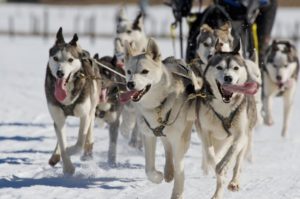March 2009 – Mind of the Musher
 Why do Iditarod mushers brave the relentless cold, the rough terrain, and the mind-numbing fatigue of the race? Beyond the challenge of the trail and the excitement of competition, the answer lies somewhere in the head and heart of a person who would gladly spend their last dime on dog food.
Why do Iditarod mushers brave the relentless cold, the rough terrain, and the mind-numbing fatigue of the race? Beyond the challenge of the trail and the excitement of competition, the answer lies somewhere in the head and heart of a person who would gladly spend their last dime on dog food.
“We didn’t even have a last dime to spend,” said Frank Torres, who ran the Iditarod in 1986. He and his wife, Betsy McGuire who ran the race in 1985, sold gear in Nome after the race just to collect enough money to buy a ticket home to McGrath. Why did they do it? Torres shrugged. “For the love of it,” he said. “It’s the lifestyle.”
Puppy Love
Many mushers get involved in the Iditarod because of the adventure, but long-timers credit their dogs for staying with the sport.
“I ran the Iditarod because I was enchanted with the history, the romance of it,” said Jack Niggemyer, Iditarod veteran and past Iditarod Trail Committee trail manager. “But I stayed because of the dogs. There’s nothing as gratifying as a good run with a good team.”
For DeeDee Jonrowe, Iditarod veteran and top competitor, mushing is a lifestyle and a connection to Alaska’s history. The highlight of the race is spending uninterrupted time alone with her dogs.
“This is the varsity team, your very best dogs. You’ve worked hard all season. It’s like a parent watching their kids in a world tournament,” she said.
Torres agreed. “The best of everything you’ve got is on the trail. Huskies are extremely smart, very savvy. The good ones want to see what’s around the next bend. They want to go.”
Do or Die
Besides admiring their dogs, Iditarod racers have single-minded desire and determination. Mushers homes become race headquarters. Kitchen tables are littered with harnesses and busted headlamps, Tang, pilot bread and coffee-stained race records.
“My whole house smelled like a wet booty,” Niggemyer said. “It takes over your life, even if you’re only half way serious about it.”
The training routine for Jonrowe goes something like this: Up at 5:30 a.m., Jonrowe does paperwork, corresponds with sponsors and plans the training. At 7:30 she waters her dogs and gets them ready for a training run. The dogs pull a cart or sled, and Jonrowe practices for contingencies during the race. Sometimes she’ll spill the sled, just to teach the dogs how to respond to an accident. Other times she releases the dogs as if freeing them from a tangle. Then she teaches them to stick around until they can be put back into harness. After three hours, they head back home, where she feeds and waters the dogs. Then it’s off to do general chores like cleaning the dog lot and clearing trail. Later she spends an hour and a half brushing the dogs and checking them over. Occasionally she has to make the 60 mile round-trip to town for supplies. Jonrowe and her husband Mike fall into bed about 9:30 to rest up for the next day’s training.
Call of the Wild
Finally, the mind of the musher is a mind that cannot resist the lure of the land.
“It’s lonely,” Niggemyer said. “There’s no Olympic training center.” Just a long wintry trail through the wilderness – which suits mushers just fine.
In an Iditarod survey, Bruce Lee, formerly of Denali Park wrote, “Somewhere back in ourselves there is a place that has ties with our bond to work with animals and travel across wild lands.”
Jonrowe said that she is still awestruck by the wild beauty of the trail. “I marvel at God’s great creation; the people he’s made, the dogs and the unspoiled landscape. It’s bigger than big.”
Dan Seavy, who ran his first Iditarod in 1973, said that for all the positive ways the race has grown over the years, he misses the solitude. During his first race, he drove his dogs from Knik to Ruby without seeing a single snowmachine. That has changed as the race has matured into an international sporting event.
Still, the sound of runners gliding over the trail, the shadows of a mountain range cast by a bright moon, and the intrigue of what lies beyond the horizon beckons irresistibly to those called to run the race.
A Little Crazy
Does this love for adventure and animals strike non-mushers as obsessive? Some may think mushers have dog biscuits for brains. Others call them heroes of the North.
Niggemeyer laughed, “Well, something happens to a person over the course of a long winter, watching a bunch of dog butts.”
Niggemyer reflected that mushers are the toughest people he’s ever met both physically and mentally. It’s not an easy life. And giving it all you’ve got is what it takes to win.
Note: A longer version of “Mind of a Dog Man” first appeared in Alaska’ Magazine’s Official Iditarod Race Program 1998.